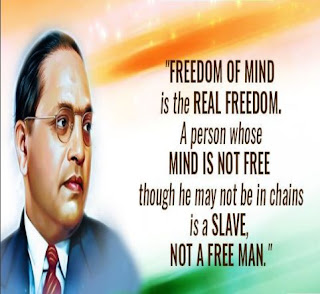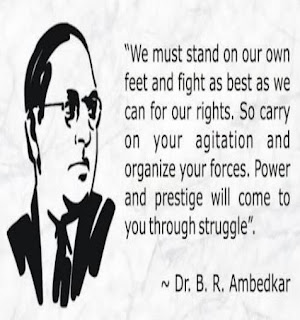Dr. Bhimrao Ambedkar Jayanti 14 April 2022
Born: 14 April, 1891Place of Birth: Mhow in Central Provinces (currently Madhya Pradesh)
Parents: Ramji Maloji Sakpal (father) and Bhimabai Murbadkar Sakpal (mother)
Spouse: Ramabai Ambedkar (1906-1935); Dr. Sharada Kabir rechristened Savita Ambedkar (1948-1956)
Education: Elphinstone High School, University of Bombay, Columbia University, London
School of Economics Associations: Samata Sainik Dal, Independent Labour Party, Scheduled Castes Federation Political Ideology: Right winged; Equalism
Religious Beliefs: Hinduism by birth; Buddhism 1956 onwards
Publications: Essays on Untouchables and Untouchability,
The Annihilation of Caste, Waiting for a Visa
Passed Away: 6, December, 1956
Dr. Bhimrao Ramji Ambedkar, popularly known as Babasaheb Ambedkar, was a jurist, social reformer and politician. He is also known as the Father of Indian Constitution.
A well-known politician and an eminent jurist, his efforts to eradicate social evils like untouchability and caste restrictions were remarkable. Throughout his life, he fought for the rights of the Dalits and other socially backward classes.
डॉ. भीमराव रामजी अम्बेडकर, जिन्हें बाबासाहेब अम्बेडकर के नाम से जाना जाता है, एक न्यायविद, समाज सुधारक और राजनीतिज्ञ थे। उन्हें भारतीय संविधान के पिता के रूप में भी जाना जाता है।
एक प्रसिद्ध राजनीतिज्ञ और प्रख्यात न्यायविद, अस्पृश्यता और जाति प्रतिबंध जैसी सामाजिक बुराइयों को मिटाने के उनके प्रयास उल्लेखनीय थे। अपने पूरे जीवन में, उन्होंने दलितों और अन्य सामाजिक पिछड़ा वर्ग अधिकारों के अधिकार के लिए संघर्ष किया।
Ambedkar was appointed as India’s first Law Minister in the Cabinet of Jawaharlal Nehru. He was posthumously awarded the Bharat Ratna, India’s highest civilian honor, in 1990.
अम्बेडकर को जवाहरलाल नेहरू के मंत्रिमंडल में भारत के पहले कानून मंत्री के रूप में नियुक्त किया गया था। 1990 में उन्हें मरणोपरांत भारत के सर्वोच्च नागरिक सम्मान भारत रत्न से सम्मानित किया गया।
Childhood & Early Life
Bhimrao Ambedkar was born to Bhimabai and Ramji on 14 April 1891 in Mhow Army Cantonment, Central Provinces (Madhya Pradesh).
Ambedkar’s father was a Subedar in the Indian Army and after his retirement in 1894, the family moved to Satara, also in Central Provinces. Shortly after this, Bhimrao’s mother passed away.
Four years later, his father remarried and the family shifted to Bombay. In 1906, 15 year old Bhimrao married Ramabai, a 9 year old girl. His father Ramji Sakpal died in Bombay, in 1912.
Throughout his childhood, Ambedkar faced the stigmas of caste discrimination. Hailing from the Hindu Mahar caste, his family was viewed as “untouchable” by the upper classes. The discrimination and humiliation haunted Ambedkar at the Army school.
Education
He cleared his matriculation in 1908 from Elphinstone High School. In 1908, Ambedkar got the opportunity to study at the Elphinstone College and obtained his graduate degree in Economics and Political Science in the year 1912 from Bombay University. Ambedkar decided to use the money for higher studies in the USA. He enrolled in the Columbia University in New York City to study Economics. He completed his Master’s degree in June 1915.
He received his PhD degree in Economics in 1927. On 8 June, 1927, he was awarded a Doctorate by the University of Columbia.
Movement Against Caste Discrimination
After returning to India, Bhimrao Ambedkar decided to fight against the caste discrimination that plagued him throughout his life. In his testimony before the Southborough Committee in preparation of the Government of India Act in 1919, Ambedkar opined that there should be separate electoral system for the Untouchables and other marginalised communities. He contemplated he idea of reservations for Dalits and other religious outcasts. Ambedkar began to find ways to reach to the people and make them understand the drawbacks of the prevailing social evils. He launched a newspaper called “Mooknayaka” (leader of the silent) in 1920 with the assistance of Shahaji II, the Maharaja of Kolkapur.
By 1927, Ambedkar launched full-fledged movements for Dalit rights. He demanded public drinking water sources open to all and right for all castes to enter temples. He openly condemned Hindu Scriptures advocating discrimination and arranged symbolic demonstrations to enter the Kalaram Temple in Nashik. In 1932, the Poona Pact was signed between Dr. Ambedkar and Pandit Madan Mohan Malviya, representative of the Hindu Brahmins relinquishing reservation of seats for the untouchable classes in the Provisional legislatures, within the general electorate. These classes were later designated as Scheduled Classes and Scheduled Tribes.
Framer of the Constitution of India
Dr. Ambedkar was appointed as the chairman of the constitution drafting committee on August 29, 1947. Ambedkar emphasized on the construction of a virtual bridge between all classes of the society. According to him, it would be difficult to maintain the unity of the country if the difference among the classes were not met. He put particular emphasis on religious, gender and caste equality. He was successful in receiving support of the Assembly to introduce reservation for members of the scheduled castes and scheduled tribes in education, government jobs and civil services.
BR Ambedkar & Conversion to Buddhism
In 1950, Ambedkar travelled to Sri Lanka to attend a convention of Buddhist scholars and monks. After his return he decided to write a book on Buddhism and soon, converted to Buddhism. In his speeches, Ambedkar lambasted the Hindu rituals and caste divisions. Ambedkar founded the Bharatiya Bauddha Mahasabha in 1955. His book, "The Buddha and His Dhamma" was published posthumously. On October 14, 1956 Ambedkar organized a public ceremony to convert around five lakh of his supporters to Buddhism. Ambedkar traveled to Kathmandu to attend the Fourth World Buddhist Conference. He completed his final manuscript, "The Buddha or Karl Marx" on December 2, 1956.
Death
Since 1954-55 Ambedkar was suffering from serious health problems including diabetes and weak eyesight. On 6 December, 1956 he died at his home in Delhi. Since, Ambedkar adopted Buddhism as his religion, a Buddhist-style cremation was organized for him. The ceremony was attended by hundreds of thousands of supporters, activists and admirers.

















No comments:
Post a Comment